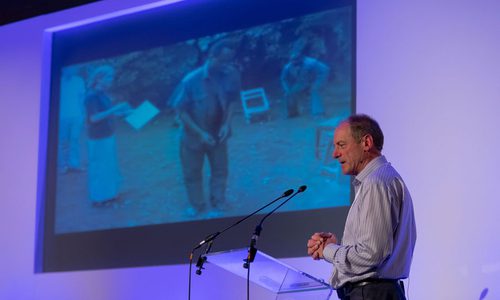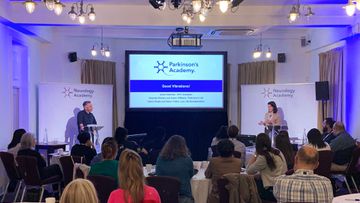What is the relationship between ageing, frailty and Parkinson’s disease?
Event reportsBack in June the Parkinson’s Academy hosted “Cutting Edge Science for Parkinson’s Clinicians”, an educational meeting sponsored by Bial Pharma. Now in its second year the meeting was a sell-out again and expectations were high. Chaired by Dr Peter Fletcher (Gloucestershire Hospitals NHS Foundation Trust), the meeting was designed to cater to the diverse needs and interests of its varied audience of neurologists, care of the elderly physicians, psychiatrists and Parkinson’s nurses.
This year, the meeting’s theme was to ‘Question everything’, to review what we already know, and to think about how clinical observations and cross-team collaborations can drive us forward. Each week we are posting an article to look at the meeting’s speaker sessions in more detail.
Prof Richard Walker
Consultant physician, North Tyneside General Hospital
said Professor Richard Walker (University of Newcastle) as he started his presentation. There is no universally agreed definition of frailty, yet we all can recognise a frail patient when we meet them. One proposed definition is “Frailty as a multi-component, dynamic state of vulnerability to adverse outcomes.”1With increasing age comes increasing interplay of comorbidities, and the interactions between conditions. PD may exacerbate other conditions, such as orthostatic hypotension – both via the underlying disease and through dopaminergic treatment. To avoid problems it is always important to consider all medications a patient is taking. In the case of orthostatic hypotension, the clinician should review any antihypotensives, anticholinergics and antidepressants that are being taken together with the patients dopamine replacement therapy.
Professor Walker explained that there are several different measures that can be used to assess frailty, including the frailty phenotype2 and frailty index. These measures have previously been demonstrated to predict mortality, institutional care placement, hospital admissions and falls. Frailty is important to recognize as there are interventions that can help maintain or increase weight and mobility.
Frailty phenotype2
Frailty defined as a clinical syndrome in which 3 or more of the following criteria were present:
- Unintentional weight loss (10lb in past year)
- Self-reported exhaustion
- Weakness (grip strength)
- Slow walking speed
- Low physical activity
Hospital admission data shows that patients with PD are almost twice as likely to stay in hospital for more than 3 months, and even more likely to die in hospital, than other patients.3 The main reasons for admission include pneumonia, motor decline, urinary tract infection and hip fractures. As Professor Walker observed, some of these are manageable, or even preventable, with good care. It is estimated that 18,000 people with PD live in a residential or nursing home setting,42 and it is worrying that evidence clearly shows gaps in care home education. While the new NICE guidelines highlight the importance of care-home patients getting medication on time, there are no other specific statements in relation to standards of good practice in care homes for PD.4 Professor Walker closed his presentation by noting that caregiver strain is a key reason for a person with PD to enter a care home. Carers describe anticipating the inevitable, but needing to reach a crisis point before care home placement occurs, with some needing a healthcare or social care professional to make the decision for them. He suggested that, for some patients, care home placement may be delayed by improved support.
References:
- Rodriguez-Manas L, Feart C, Mann G, et al. Searching for an operational definition of frailty: a Delphi method based consensus statement: the frailty operative definition-consensus conference project. J Gerontol A Biol Sci Med Sci 2013;68(1):62-67.
- Fried LP, Tangen CM, Walston J, et al. Frailty in older adults: evidence for a phenotype. J Gerontol A Biol Sci Med Sci 2001;56(3):M146-156.
- Low V, Ben-Shlomo Y, Coward E, Fletcher S, Walker R, Clarke CE. Measuring the burden and mortality of hospitalisation in Parkinson's disease: A cross-sectional analysis of the English Hospital Episodes Statistics database 2009-2013. Parkinsonism Relat Disord 2015;21(5):449-454.
- Walker RW, Palmer J, Stancliffe J, Wood BH, Hand A, Gray WK. Experience of care home residents with Parkinson's disease: Reason for admission and service use. Geriatr Gerontol Int 2014;14(4):947-953.43.NICE. Parkinson’s disease in adults. Available at: nice.org.uk/guidance/ng71. 2017.

This meeting was designed and delivered by the Parkinson’s Academy and sponsored by Bial Pharma. The sponsor has had no input into the educational content or organisation of this meeting.
Related articles
'The things you can't get from the books'
Parkinson's Academy, our original and longest running Academy, houses 23 years of inspirational projects, resources, and evidence for improving outcomes for people with Parkinson's. The Academy has a truly collegiate feel and prides itself on delivering 'the things you can't get from books' - a practical learning model which inspires all Neurology Academy courses.









